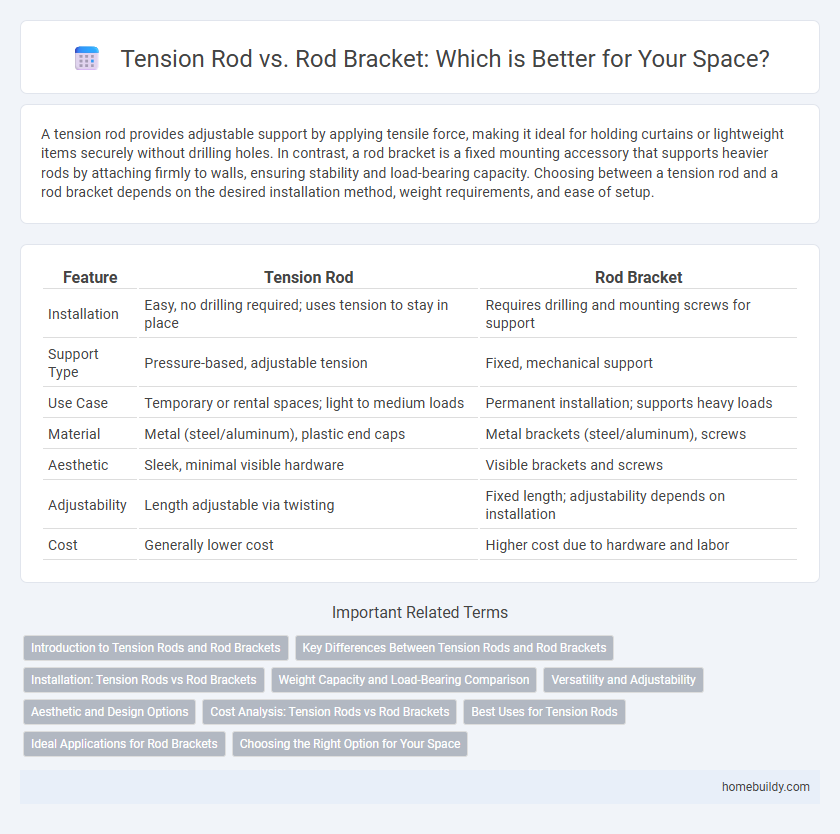A tension rod provides adjustable support by applying tensile force, making it ideal for holding curtains or lightweight items securely without drilling holes. In contrast, a rod bracket is a fixed mounting accessory that supports heavier rods by attaching firmly to walls, ensuring stability and load-bearing capacity. Choosing between a tension rod and a rod bracket depends on the desired installation method, weight requirements, and ease of setup.
Table of Comparison
| Feature | Tension Rod | Rod Bracket |
|---|---|---|
| Installation | Easy, no drilling required; uses tension to stay in place | Requires drilling and mounting screws for support |
| Support Type | Pressure-based, adjustable tension | Fixed, mechanical support |
| Use Case | Temporary or rental spaces; light to medium loads | Permanent installation; supports heavy loads |
| Material | Metal (steel/aluminum), plastic end caps | Metal brackets (steel/aluminum), screws |
| Aesthetic | Sleek, minimal visible hardware | Visible brackets and screws |
| Adjustability | Length adjustable via twisting | Fixed length; adjustability depends on installation |
| Cost | Generally lower cost | Higher cost due to hardware and labor |
Introduction to Tension Rods and Rod Brackets
Tension rods are adjustable metal rods designed to hold objects securely by applying tension between two surfaces, commonly used in closets and curtain installations. Rod brackets are fixed support fixtures that hold stationary rods in place, providing structural stability without adjustability. Choosing between a tension rod and a rod bracket depends on the need for flexibility in length adjustment versus fixed support for heavier loads.
Key Differences Between Tension Rods and Rod Brackets
Tension rods are adjustable metal rods designed to fit snugly between two surfaces, providing support without the need for permanent fixtures, commonly used for curtains or shower curtains. Rod brackets, in contrast, are fixed hardware pieces that mount directly onto walls or surfaces to hold rods in place securely and require screws or anchors. The key difference lies in installation: tension rods rely on pressure for support and are easily removable, whereas rod brackets offer a more stable and permanent structural solution.
Installation: Tension Rods vs Rod Brackets
Tension rods offer a tool-free, adjustable installation process that relies on spring tension to securely hold curtains without drilling, making them ideal for renters or temporary setups. Rod brackets require fixed mounting using screws and anchors, providing a more permanent and sturdy solution suitable for heavier curtains or long-term installations. The choice between tension rods and rod brackets depends on the balance between convenience and durability during curtain installation.
Weight Capacity and Load-Bearing Comparison
Tension rods typically support moderate weight capacities ranging from 20 to 50 pounds, relying on tension to stabilize curtains or lightweight loads. Rod brackets, made from heavier materials like metal or reinforced plastic, often handle higher load-bearing capacities exceeding 100 pounds, suitable for heavy drapes or shelving. Comparing their load-bearing abilities, rod brackets offer superior strength and durability for heavier applications, while tension rods provide quick, tool-free installation for lighter weight needs.
Versatility and Adjustability
Tension rods offer superior versatility and adjustability compared to rod brackets by allowing easy length modification without drilling or permanent fixtures. Their spring-loaded mechanism adapts seamlessly to various window sizes and shapes, providing flexibility in installation and repositioning. Rod brackets, while sturdy, require fixed mounting points and lack the quick adjustment feature, limiting their adaptability to changing decor or window treatments.
Aesthetic and Design Options
Tension rods offer a sleek, minimalist appearance ideal for modern interiors, while rod brackets provide more decorative options and variety in materials and finishes. The streamlined design of tension rods allows for unobtrusive installation, complementing contemporary aesthetics without bulky hardware. Rod brackets enable customization with ornate shapes and detailed craftsmanship, enhancing traditional or transitional design schemes.
Cost Analysis: Tension Rods vs Rod Brackets
Tension rods are generally more cost-effective than rod brackets due to lower material and installation expenses, making them a budget-friendly choice for lightweight applications. Rod brackets, while often pricier, provide enhanced durability and support for heavier loads, justifying their higher upfront cost in long-term projects. Evaluating project needs and load requirements is essential to determine the most economical option between tension rods and rod brackets.
Best Uses for Tension Rods
Tension rods excel in applications requiring adjustable, no-drill installation such as hanging curtains, shower curtains, or lightweight room dividers, offering easy repositioning and damage-free wall support. Unlike rod brackets that rely on permanent fixtures and screws, tension rods use spring tension to hold securely between two surfaces, making them ideal for renters or temporary setups. Their versatility and quick installation make tension rods best suited for spaces where flexibility and minimal wall impact are priorities.
Ideal Applications for Rod Brackets
Rod brackets offer superior support in heavy-duty applications where tension rods alone may not provide adequate stability, such as in industrial shelving, heavy drapery, or large-scale curtain installations. They are ideal for securing rods to walls or ceilings, ensuring minimal sagging and enhanced load distribution under significant weight. Their structural reinforcement makes them preferred in both commercial and residential settings requiring robust fastening solutions.
Choosing the Right Option for Your Space
Tension rods offer a flexible, tool-free installation ideal for temporary or lightweight applications, making them perfect for renters or quick room updates. Rod brackets provide a more secure, permanent solution suitable for heavier curtains or built-in aesthetics, ensuring long-term stability and durability. Evaluating your space's wall type, curtain weight, and desired permanence helps determine whether a tension rod or rod bracket best meets your functional and design needs.
Tension rod vs Rod bracket Infographic

 homebuildy.com
homebuildy.com